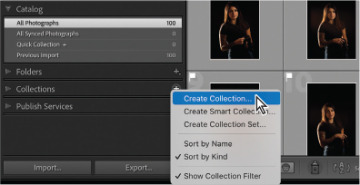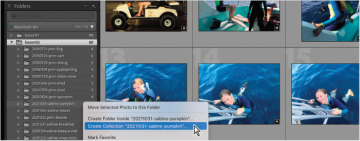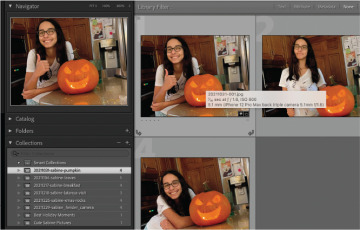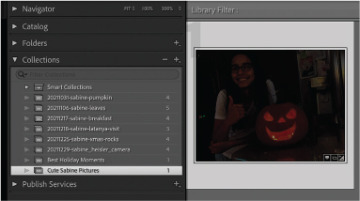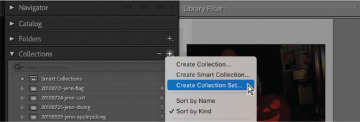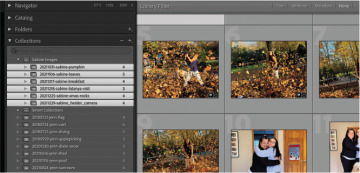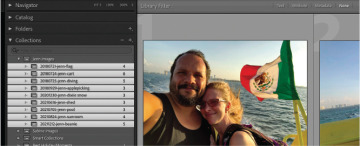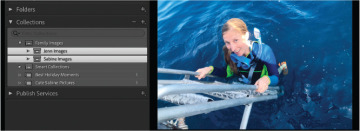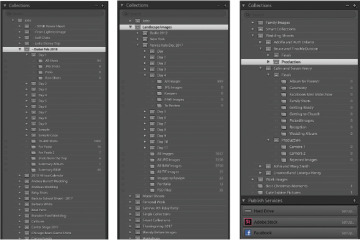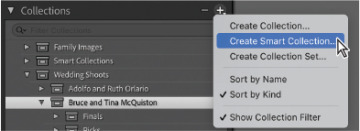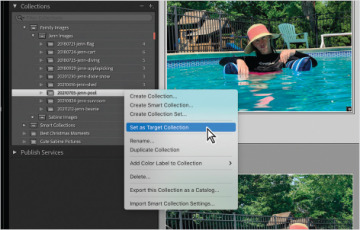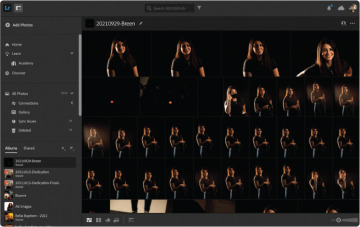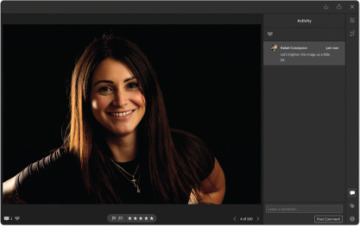What is a collection?
As your Lightroom library gets bigger and bigger, you’ll need to have key images in your catalog accessible for various purposes. As mentioned, prior to Lightroom, photographers who wanted to share a group of images, like a portfolio of portraits, often placed copies of those pictures in a folder to share. As different needs arose, they had to create other folders and store more copies of the same pictures in them. Each folder had a specific need and contained copies of pictures that also lived in other folders. Keeping track of the copies, and the space they occupy, makes this solution untenable. This is where collections save the day.
If you’re familiar with buying digital music, you can think of Lightroom collections as playlists for your pictures. You purchase one song and own one physical copy of a song, but that song can live in an unlimited number of playlists. The same holds true for pictures and collections in Lightroom.
On the left side of the Library module, you have a Collections panel. Click the plus sign (+) in the panel header, choose Create Collection, and give the collection a name. From there, you can add images from throughout your catalog to the collection, no matter what folder they live in, and you can add as many collections as you need for organization.
Every collection that you create in Lightroom can hold images from any folder you have imported into your catalog. It doesn’t matter if the images live on your hard drive, an external drive, or a network-attached storage drive. The Lightroom catalog (your digital notebook) notes that you have one physical file but would like to have a reference to that file in multiple collections. The collections serve as a way to look at disparate parts of your photographic life without having to change your folders or make copies of your photos to live in different folders. This is an extremely powerful feature and one that your photographic life will revolve around.
In an effort to show you this concept in its simplest form, I’ll share with you a series of photos of my daughter, Sabine, and my wife, Jennifer.
Creating collections from folders of images
Let’s experiment with creating collections and adding images to them with the files that we’ve imported for Lesson 2.
Go to the Folders panel in the Library module and click the little triangle to the left of the Lesson 02 folder. Inside that folder, you’ll see a series of folders that we’ll make into collections.
Right-click one of the folders that contains the word Sabine in the name, and select Create Collection “folder name” from the menu.
Repeat this with all of the other folders that have the word Sabine in their names, making collections for each of them. When you’re done, you should have a total of six collections.
Press Command+D/Ctrl+D to deselect all photos. Click the plus sign (+) on the right side of the Collections panel’s header, and create two additional collections: Best Holiday Moments and Cute Sabine Pictures, as you see here on the right.
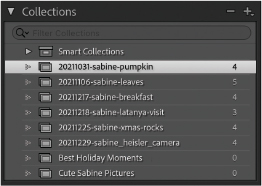
While it might seem repetitive to have collections that are named exactly like your folders, there are a couple of really powerful things happening under the hood here. First, unlike in a folder, you can drag the images around within the preview area and sort them into whatever order you like.
Second, you have the option to add images from any of those Sabine collections to the Best Holiday Moments or Cute Sabine Pictures collections. It doesn’t matter where those images live or what folders they are in, you can simply drag any of them into a new collection if you’d like. The catalog (your digital notebook) will still reference that one physical file.
To show you the third important part about collections, click the thumbnail of the first picture in the 20211031-sabine-pumpkin and drag it into both the Best Holiday Moments and Cute Sabine Pictures collections.
Although we haven’t covered developing a picture yet, let’s make a quick change to this photo. On the right side of the Library module, open the Quick Develop panel’s Tone Control section. Under Exposure, click the double left arrow three times. This should darken the image by three stops. You will see the change in the image in this collection immediately.
The awesome part about this is that the thumbnails of this image in the other two collections also will change to reflect the darker picture. You don’t have to remember where the physical picture lives; Lightroom automatically makes that change across all instances of the image by referencing that one physical file.
Before we go any further, let’s create collections for the rest of the folders in the Lesson 02 folder (all of the folders with the word Jenn in them). You should then have a total of 17 collections.
Creating collection sets
It’s easy to see that our list of collections could get a little unwieldy. With so many Sabine collections, it would be hard to scroll and visually see where my work images are versus my family images. That said, there is a common element that runs through all of these collections of Sabine: my daughter, Sabine.
Click the plus sign (+) on the right side of the Collections panel’s header, and select Create Collection Set. In the Create Collection Set dialog box, create a set called Sabine Images, and make sure the Inside A Collection Set check box in the Location area is unselected. Once the collection set is created, drag all of the Sabine collections into the Sabine Images collection set.
The result is a much cleaner look to the Collections panel. If you want to see the pictures inside all the Sabine collections, just click the Sabine Images collection set. If you want to see pictures from one of the individual collections, click that individual collection.
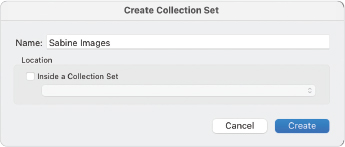
We can take this a step further. The Jenn collections also could benefit from that type of grouping. Create a collection set called Jenn Images, and make sure the Inside A Collection Set check box is unselected. Then, drag all the Jenn collections inside the Jenn Images collection set. This makes our collections even cleaner.
We can still take this level of organization further. Another great benefit of the collection set is that it holds not only collections but other collection sets as well. Looking at the collections that you have here, are there any other common elements that we can group around? Jenn and Sabine are my family. We could theoretically create a collection set called Family Images and place both the Sabine Images and Jenn Images collection sets in it.
Then, should we want to see all the family images, we could click the Family Images collection set. If we want to see a series of Jenn images, we can click the Jenn Images collection set. If we want to see Sabine images, we can click the Sabine Images collection set. To see individual events, we can click the individual collections to drill down further. In other words, a place for everything, and everything in its place.
Sample organizational sets
Now that we know that our collections can be used to see a subset of pictures across our catalog and that collection sets can let us organize all of those views, let’s put it into other workflows that make sense.
Let’s say I work doing people photography, and I get an assignment to make a series of pictures of my friend Latanya Henry. In that shoot, I would have several groups of pictures—picked images to go over, rejected images, images that I want to edit further, images to take into a slideshow, and so on. If I made a collection for each group, what would happen if I got hired again to make another series of pictures for Latanya? Would I just create “Latanya Picked Images Number 2” and name the other collections in the same manner? That would be too messy.
Instead, what if we made a collection set for Latanya Henry? Then, when I import the first shoot with Latanya, I would make a collection set for that specific shoot. Inside it, I would place all the collections that are related to that shoot.
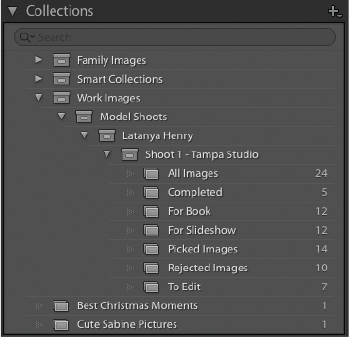
The next time I shoot with Latanya, I would create a collection set for that second shoot, and repeat the process. Not only does this allow you to see only what you want to see, but it also lets you separate out individual images for the other functions in Lightroom, such as books or slideshows. You can have a collection for each function.
On the next page are a series of sample suggestions that you can use to organize your photography work. If you are a wedding photographer, you can use collection sets on a per couple basis, with a collection set for each couple’s wedding. Inside each wedding, you can separate production work (shots from multiple cameras) and the finished work, using collections to sort out the various pieces of the wedding.
If you are a commercial photographer who does multi-day shoots, you can make a collection set for the entire job, organize the days into individual collection sets, and filter out the best shots into a “best of” collection. If you are a landscape pho-tographer, the organization would be similar to that of a commercial shoot, but instead of jobs, you can sort by locations.
These samples are provided as ideas to get you going, not as hard-and-fast rules for your photography work. The point is that you should take a moment to plan how you want to organize your Lightroom catalog using collections and collection sets. Once you do, it’s up to you to stick to that format. It’s a little time-consuming at first, but it pays great dividends later on as your catalog gets larger.
What is a smart collection?
Smart collections are collections that you build based on predefined criteria. Click the plus sign (+) on the right side of the Collections panel’s header, and choose Create Smart Collection from the menu.
In the Create Smart Collection dialog box, you can pick from a ton of different criteria to pull images into your smart collection. Below the Match menu, the left side shows you the criterion chosen, the center section gives you comparison options, and the right side gives you the restrictions for each criterion. Click the plus sign (+) at the upper right of the rules field to add another criterion (you can have as many as you want).
Once the smart collection has been created, you will see it in the Collections panel with a number of images in it. The number of images in a collection increases or decreases as you flag images across your entire catalog. In this example, I created a smart collection that will keep track of images that I mark as rejected. As I flag my images, no matter where in the catalog the rejected ones live, Lightroom will keep a running tally of them inside this smart collection.
I recommend that you drill down into that column on the left during your smart collection creation. You’ll find a ton of parameters that you can immediately put to use in sorting your photographic work.
What is the Quick Collection?
There may be times when you don’t necessarily need to create a collection, but would like to temporarily organize a set of images into a group. Rather than creating and deleting a regular collection, moving images around, or exporting images unnecessarily, you can use the Quick Collection. The Quick Collection does not live in the Collections panel and is available to you by clicking Quick Collection in the Catalog panel or pressing Command+B/Ctrl+B.
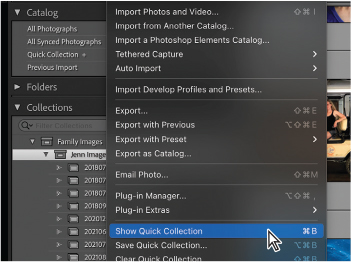
Add images to the Quick Collection as you move about the Library module by selecting an image and pressing the B key. Or, in Grid view, click the small Quick Collection circle in the upper right of any thumbnail; it turns gray to show you that the photo has been added to the Quick Collection.
What is a target collection?
A target collection takes all the ease of adding images to the Quick Collection, and following the same process, assigns the images to one of the regular collections you’ve created. To use this feature, right-click a collection you’ve already created and choose Set As Target Collection (you’ll see a plus sign [+] appear to the right of your collection name). Now, every time you press the B key, the selected image will be added to the target collection you specified, and not to the Quick Collection. To turn the target collection off, right-click it in the Collections panel and choose Set Target Collection from the menu again. Then, the images will go back to being added to the Quick Collection.
Sharing your collections online
Another benefit of having your images in collections is that you can share the collections online. Previously, if you needed to get feedback on a shoot from someone else (a client, family members, friends), you would have to export images from the collection and import them into a third-party website.
In Lightroom Classic (desktop), you can automatically sync a collection with Lightroom (mobile) once you turn syncing on. Click the cloud icon at the right of the Module Picker and click Start Syncing. Then, select the Sync With Lightroom option in the Create Collection dialog box. If you forget to do this when creating your collection or decide to sync it later, simply click the lightning bolt icon to the left of the collection name. Lightroom Classic will generate the files and automatically create an album in Lightroom, as well as a private website you can view by logging in at lightroom.adobe.com. You can make the gallery public by clicking the Make Public button in the upper-right corner of the preview area.
After you click Make Public, Lightroom Classic creates a URL that you can share with others (to the left of the button you clicked to make the website public, once you have made it public). In the online version of Lightroom (which has fewer features than Lightroom Classic), all flags, star ratings, color labels, and other metadata settings will appear with the images (as you can see in Grid view below).
After clicking a thumbnail, you are taken to Loupe view, where you can click the Info icon to see the photo’s metadata or the Activity icon to leave a comment or read other viewers’ comments. Those comments are automatically saved to the cloud and then synced back to your computer for you to review in the Comments panel (which appears below the Metadata panel in Lightroom Classic once a collection is made public).
